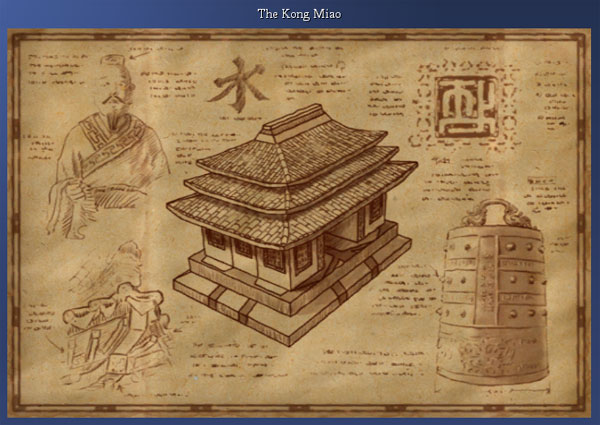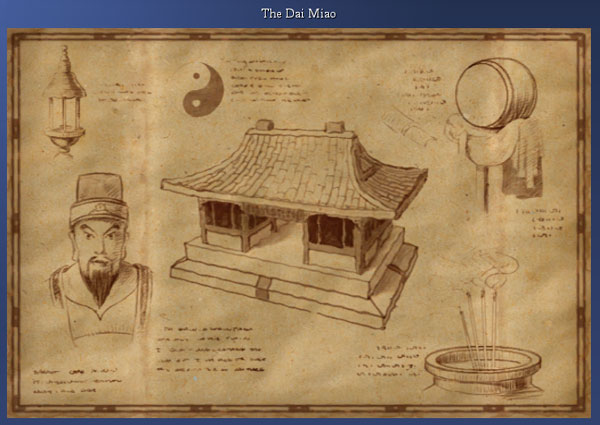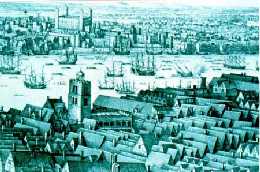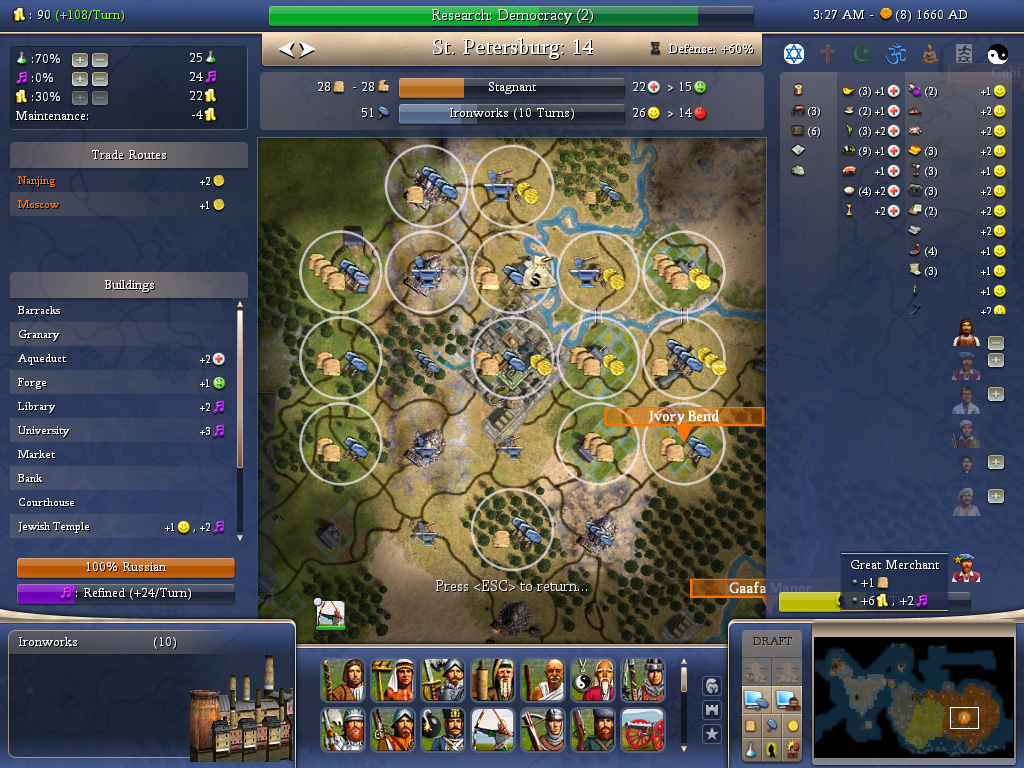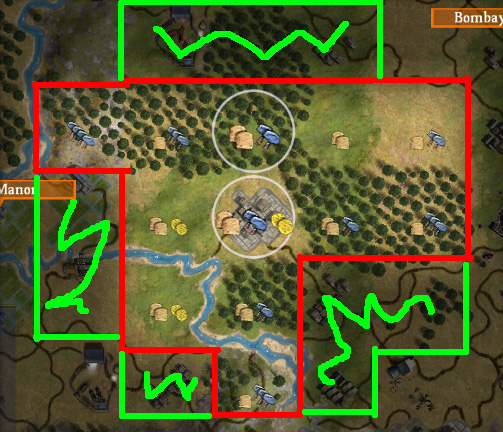Part 28

So long as man marked his life only by the cycles of nature--the changing seasons, the waxing or waning moon--he remained a prisoner of nature. If he was to go his own way and fill his world with human novelties, he would have to make his own measures of time. And these man-made cycles would be wonderfully varied. -- Daniel J. Boorstin, The Discoverers
So it is my theory that we are the Third Men. The First Men were not Men but Man, Individual and Master, whose bowstring was a cord of fresh sinew. The Second Men were the Degenerates, the Moral Men of a settled character, the Farmers who broke their bows and hunched in fields of grain. They called this the Classical, the Medieval, the Renaissance. The Third Men are the mindless, the Crushed Minds, the amoral souls like their machines. They called this the Industrial; they call this the Modern.
But Industry isn't dead. You call this the Future? Future hasn't happened yet. There are no Fourth Men.
Welcome to the endless Industrial Age.
-- an excerpt from dunprav's file, Who?
Warning: This file contains aberrant rhetoric. By order of the Russian World State, all deliberate dissemination via photocopies, transcripts, quotations, or repetitions of any kind--vocal, electronic, or personal--are prohibited except for critical or educational purposes. This is a restricted file; please access no more than one restricted file in a week. Further accesses are crimes punishable with a fine of up to $100 dollars and ten days of confinement. Unauthorized dissemination of the file is a crime punishable with a fine of up to $1000 dollars and six months of confinement.
Opening the Industrial Era
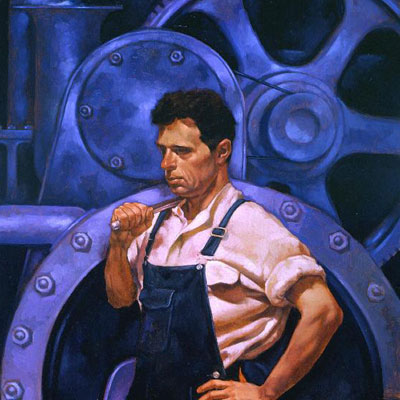
"Industrial Age," oil on canvas, by Valentin Serov
December 12th, 1582.
The first dawn of the Industrial Era slipped between the horizon and the clouds. Ruddy bands of sunlight spread across the icy hills and settled on the eaves of Moscow. Last night, the remnants of a broad tethyscycle had collided with a breath of antarctic chill. The storm had frozen and settled in thick, teary drops of sleet. After the ice had fallen, the dark clouds had remained, dense as steel and infinitely oppressive. Beneath this dreadful shade, a few workers paused to watch the sun. It passed above the storm's opaque edge, setting as soon as it had risen and casting Moscow back into darkness.
The historian Nikolay Karamzin noted these events in his journal, and then he retired to his bedroom to sleep for the rest of the morning. When he arose in the afternoon, he composed the following line for his account of the Renaissance.
"The most violent epochs begin most unobtrusively, as a rule of universal irony. What demon or deity would plot a peaceful history, except in anticipation of greater entertainment?"
His words were more appropriate than he imagined. Nearly six decades passed before the gears of conflict began to grind again, but when they did, they milled gunpowder for one of history's longest and most brutal wars.
Sixty Years of Peace
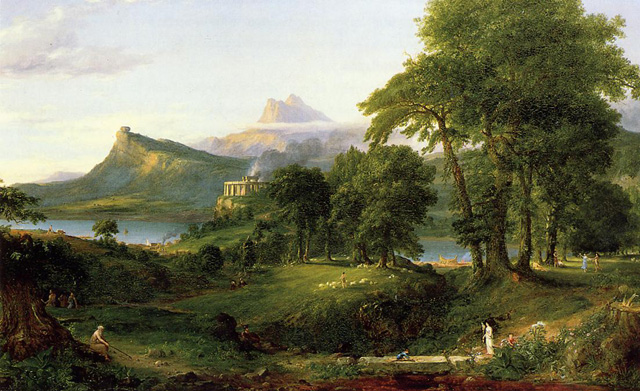
Sometimes known as the Pastoral Interim, the opening six decades of the Industrial Era were a calm--but vibrant--time of intellectual growth. Russangxi writers raised the heretofore unappreciated novel into a respected artform; Russangxi painters played with their impressions of light and shadow; Russangxi merchants plied the trade routes and kept books in the manner of Hanno the Navigator; and scholars and scientists of all kinds refined the methods and theories of the Renaissance.
In the following sections, I will review several of the key events of this mini-era and their lasting influences.
1. Renovating the Great Temples
In the arid hills northwest of Grozny, Taoist monks had built and maintained a minor temple along the inside of Charyn Canyon. The canyon's natural beauty and the temple's marvelous "hanging" design were world-renowned, yet the temple drew only a handful of worshipers annually. Because of its remote wilderness location, very few pilgrims could afford the supplies necessary to reach it.
The Taoist Sage Liu Xiaogan felt that its remoteness was a lost opportunity. He championed and eventually implemented a plan expanding the temple's interior and building a road connecting it to Grozny.
Though Sage Liu died several decades before his plans were completed, he was confident that the temple would succeed admirably. And it did. After the renovations were finished, the original copies of Euclid's Philosophies & Tao were moved from Obeshchan's estate to the temple, and it was honored with the title of the Dai Maio. As the new Great Temple of the Taoists, it drew an inordinate number of worshipers and increased Taoist income with their tithes.
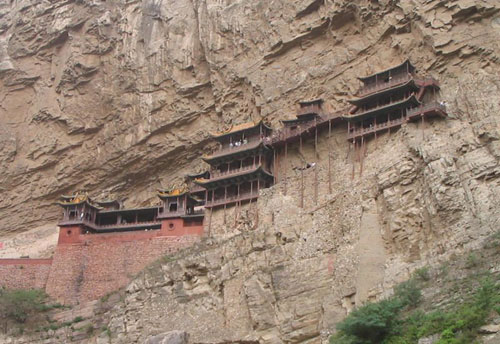
This is the exterior of the Dai Miao. The current temple extends almost a quarter of a kilometer into the cliffside. Because of its remote location and high electrical load, it's supplied with electricity by the world's second longest dedicated power line.
Master Mou, Sage Liu's contemporary and rival, began and finished a similar, smaller project on behalf of Confucianism. On one of the lower peaks in the Sunspine range, the Confucian holy temple was expanded, and a proper stairway was hewed out of the mountainside. Using dynamite-cut granite, workers paved a cobbled path from the fog-swathed summit to the heart of Bombay. Like the Dai Miao, this temple, the Kong Miao, increased Confucian income.
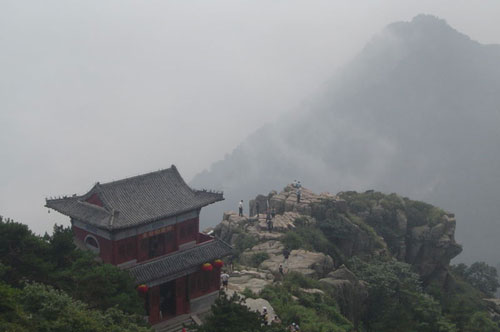
The exterior of the Kong Miao. The current temple is one of Bombay's most popular Tourist attractions. Ironically, more tithes are collected today from the Touring Buddhists than are collected from Confucian pilgrims.
The renovation of the temples marked the start of a growth period for the philosophical religions. Taoism in particular would grow for centuries to come, eventually starting the Great Taoist Revival.Aside posted:
So I took my 2 great prophets and built the two holy temples which I'd forgotten to build for the last 40 turns. The Kong Miao and the Dai Miao earn me a hefty chunk of commerce. For each Taoist and Confucian city, I earn +1 gold. Combine that with the commerce bonuses, and I can often earn +50 or +100 gold just from the religions. Yay!
Only one holy temple hasn't been built. It seems that the Islamic holy city does not have its holy site. I wonder where it is.
2. Introducing the Industrial Calendar
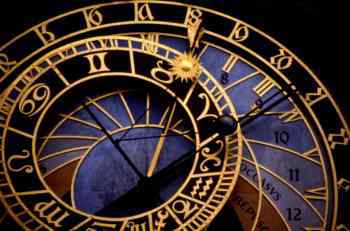
The Xiaogan-Rutskoy Calendar (commonly known as the Industrial Calendar) was the invention of the Executive of Parliament Aleksandr Rutskoy and the Taoist Sage Liu Xiaogan.
Since the 3rd millennium BC, the Abrahamic 7-day-week calendar had reigned supreme throughout the far West. In the 4th century AD, German traders had brought it to Russian shores, and the Russians had quickly adopted it as a replacement for their local lunar calendar. The solar calendar helped the farmers accurately plant and harvest with the seasons, thereby increasing their agricultural production. Its adoption was one of the great technological advances of classical Russia.
In 1622, Aleksandr Rutskoy attempted to replace the Abrahamic calendar with his own design, the "decimal calendar." He failed terribly. Parliament showed little interest in upsetting the cultural institution of the Abrahamic calendar, even though Rutskoy's design was far more accurate--it contained months of equal length and it properly tracked the drift of the solstices across the days.
It had twelve months of thirty days, with three ten-day weeks per a month, plus a yearly half-week. Every four years a sixth day was appended to the half-week, except for every eighth leap year, which was delayed until the next year. This completed a 33-year cycle that consisted of seven four-year leap years and one five-year leap year. After about 4000 years, one of the 33-year cycles would have to be reduced to a 32-year cycle to maintain the calendar's accuracy, but otherwise, Rutskoy's design was supremely accurate. Unlike in the Abrahamic calendar, the decimal dates for the equinoxes and solstices would never change.
Unfortunately, except for its mathematical accuracy, his design seemed to have no practical appeal. After one failed hearing, he set it aside for two decades and concentrated on his career. His completed a residency at the Great Library, and he entered politics as a Taoist Denaturalist. He was voted one of Moscow's representatives, and because he was a savvy politician, he was quickly elected into the Executive office. Finding himself with access to the state treasury, he indulged himself and quietly founded a public journal for natural philosophy, Physics & Metaphysics. In the first issue, he published his calendar design, and feeling satisfied with his contribution to the sciences, he concentrated on politics.
Three years later, Sage Liu read the journal, discovered Rutskoy's calendar, and immediately realized that he'd found a masterwork. Furthermore, he knew how to convince the political elite to pass the calendar into law. He was surprised that Rutskoy had missed the obvious, practical, and economic benefit of the decimal design.
But before selling it to Parliament, he gave the calendar its modern character. He assigned the first day of the new year to the winter solstice, and he moved the half week to the center of the year so that the summer solstice would occur "between" months. He gave each month and day a name, and he chose the central half-week to be holidays.
The months were originally named: Glace, Plew, Nauze, Grane, Fler, Arb, Seel, Porr, Chal, Feul, Ara, and Brow. These names are translated to the common months: Ice, Rain, Cloud, Seed, Flower, Tree, Sky, Stone, Heat, Leaf, Air, and Fog. The days of the week were given generic names, Firstday through Tenthday, to compliment their individual names. The half-week occurred between Tree and Sky, and the days were named: Sun's Day, Moon's Day, Earth's Day, Star's Day, and Man's Day. The leap day was named Time's Day. This half-week was named the Celestial Week.
Sage Liu traveled to Moscow to present the named calendar to Rutskoy. At first, Rutskoy declined to meet with him, but Sage Liu was persistent. After a few days, Liu received an audience and showed Rutskoy that adopting the new calendar would increase industrial productivity. The argument was deceptively simple. In 70 days, the Abrahamic calendar included 20 days of rest (technically ten, since most people worked six days per week). 70 days under the Rutskoy calendar only included 14 days of rest (technically seven, since most people would work on the ninth day). This meant that adopting the decimal calendar would increase national productivity by about two and a half workdays every month. And what lawmaker could refuse to approve a calendar that increased national productivity? There was a minor debate between them regarding the proximity of the rest days--Sage Liu wanted one in the middle of the week and one at the end--but Rutskoy had the final call, and he only agreed to aid Sage Liu on the condition that the days of rest would come together at the end of each week.
Of course, the calendar's passage into law wasn't easy. Rutskoy spent the rest of his career backing its adoption, and he only succeeded after the business-minded Russangxi swept Parliament in the 1650s. Furthermore, Liu, Mou, and Rutskoy died long before their calendar was completely adopted in 1753, when the province of Delhi abandoned the Abrahamic calendar while under pressure from Russangxi corporations. But the seed of cultural change--the revolution that became the Renovation--began at the beginning of the Industrial Era, when the Empire legally abandoned the old calendar for the new.
3. The Great Standardization Project

The Kilogram Calibrator. This artifact's mass defined the standard kilogram for centuries.
Prior to the Industrial Era, scientific units were "dimensionally incompatible." This meant the measurement of volume had no standard relationship to the measurement of distance, the measurement of distance had no standard relationship to the measurement of force, and so on and so forth. Worst of all, nothing accurately standardized the measurement of time. The three great clockmaker's guilds kept three different "standard" seconds, and scientists often had to list their clock's brand and production year in order to vaguely indicate how long their seconds lasted.
In response to this shoddy state of affairs, the Great Library began the Standardization Project. It established a unified set of measurement scales with common conversion factors based on the powers of 10 whenever possible. This simplified dimensional analysis and made it easier for research assistants and engineers to handle routine calculations.
Of course, to create a standard, one needed a benchmark. The Standardization Project created a set of artifacts called the Calibrators. These artifacts physically instantiated the measured units, allowing manufacturers to properly calibrate their scientific instruments. Today, the Calibrators have been replaced by standards derived from the physical constants; but until their retirement, they were fundamental to the practice of science.
Furthermore, by virtue of being created, the Calibrators forced the development of accurate machine tools--drills, blades, and other mechanical devices which could "machine"--i.e. selectively remove metal and sculpt parts. The Kilogram Calibrator, for example, was first accurately reproduced by Johann Borges, a German immigrant clockmaker, who modified a watchmaker's lathe and used it to carefully sculpt and weigh copy kilograms. Arguably, the Russian World State owes a larger debt to that single innovation than to any calibrated unit. Without the industrial lathe, gunsmiths wouldn't have been able to produce the rifles that won the Long War.
4. The Buildup to the Long War
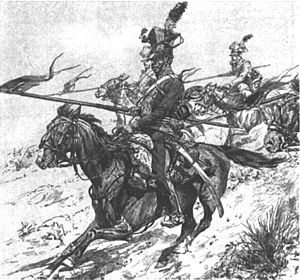
The Long War lasted more than a technological age. During the conflict, generals saw the introduction, use, and complete retirement of Cossack Cavalry.
The Industrial Era is sometimes called The Era of the Long War. The Long War is technically not the longest war ever fought--many of the earliest wars were waged on and off for centuries--but it is the longest unbroken conflict in human history. What follows is a broad account of the events leading to its inception.
1650 AD to 1655Aside posted:
So these are the turns between me and the next big war. This shouldn't take too long to start, actually. But the war itself will probably take up almost the entire Industrial Era.
In late May (middle-late Flower) of 1652, General Durvin Nostikoff observed a demonstration of gunnery from horseback. The horseman, Bogdan Khmelnitsky, was a master breeder of Novgorod and a member of the Cossack clan. Nostikoff was impressed with Bogdan's talents and mobility, and began to consider the potential for musket-carrying cavalry to replace the slower, heavier knight.
In the last hundred years, Russian siege tactics and gonne-warfare had spread to Egypt and Germany. Nostikoff understood that these tactics were inherently defensive. In a battle of equally advanced forces, armed defenders would have the decisive advantage, with more time to aim and more chances to shoot. If the Russian military were going to maintain its edge, it needed rapid assault troops.
In 1654, Nostikoff turned this thinking into a book of military theory, Doctrine: Mobilization. He noted that during training exercises, Russian defensive lines took long breaks between shots and had little defensive flexibility or mobility. If he were assaulting his own lines, he supposed that long-range bombardment--suitable to disrupting the enemy's line--could provide the opening for a lightning fast horseback assault to rout the enemy.
But by his reckoning, only light cavalry would be fast enough. For that reason, he returned to Bogdan in 1655 and hired the horse trainer along with roughly three dozen members of the Cossack clan. These Cossacks were assigned to retrofit and train existing knight units in the art of horseback marksmanship. This radical change earned Nostikoff the enmity of many of his peers, but he felt the political cost was worthwhile. He was certain that musket-armed cavalry would prove themselves to be the newest, deadliest weapon in the Russian arsenal.
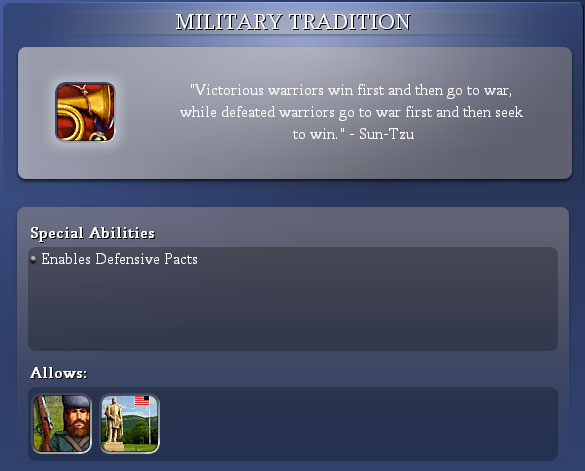
The long centuries of war birthed Russia's Military Tradition. The Military became a cultural thing-unto-itself, existing to prepare for wars that hadn't yet occurred.
---other events---Aside posted:
Military tradition is a great technology, especially for the Russians.
Let's talk about UNIQUE UNITS. Each Civilization gets one regular unit upgraded to a super-version of itself. In Warlords, most of these units are better balanced, but in Vanilla, the Cossack is probably the most overpowered unique unit in the game.
But before I talk about the Cossack, let's talk about Military Tradition in general. First, it enables Defensive Pacts, which are very useful when you haven't been warring on everyone since the dawn of time. Because I simply won't use them, I won't talk about them.
It allows you to build the West Point national wonder. West Point gives all units built in that city a +4 experience bonus.
It also allows you to build cavalry, which are a strength 15 move 2 mounted unit. They're an accessible, very powerful unit, making them the weapon of choice in the early Industrial Era.
Cossacks are the Unique Unit version of Cavalry. They are strength 18, move 2. This makes them broken powerful, since the counter-unit, rifleman, are fairly deep into an expensive branch of the Industrial tech tree. We're going to use Cossacks to do most of the damage to Egypt.
In the 1650s, the growing Russangxi party made their first inevitable conquests in Parliament. With the liberal contingent destroyed, the Russangxi painted themselves as the opposition party to the Denaturalists. Furthermore, they used their ethnic and linguistic heritage to influence voters across a broad range of social classes. They enjoyed the loyalty of businessmen, bankers, aristocracy, merchants, trade sailors, craftsmen, guildsmen, day laborers, fishermen, and farmers. And as long as the lines between the races blurred and Russangxi remained the language of the economy, Russangxi political influence would continue to grow.
1656 to 1660
In 1657, Nostikoff completed Doctrine: Mobilization and paid a vanity publisher to print approximately 150 copies. A few went to the Great Library, while the rest were distributed to interested members of Parliament and a handful of generals. The book was initially met with skepticism, but Nostikoff won a core group of converts by performing public field exercises based on his figures. The proof was in the pudding, so to speak, when lightly armored horsemen crossed 100 meters of no-man's land in a little over seven seconds--about 1/20th of the average reload time for a musket. Even a rotating firing line, which Nostikoff believed would be the most effective counter-tactic, couldn't slow such a rapid advance.
---other events---
In 1659, the last acres of the Yangtse were destroyed near Chengdu. The world's greatest jungle became a fading memory. The regional government celebrated the event by raising a plaque, "To honor the industrious men of China for eliminating a natural scourge." The region was officially renamed to the Yangtse Flats. Unknowingly, the construction of the China Megalopolis began.
In the same year, St. Petersburg suffered from a famine. In the fields around the city, a rust fungus devastated the wheat crops. Fearing starvation and civil unrest, Tsar Kavkaz V asked Parliament to feed the city until the famine ended. They complied, and starting in 1660, Moscow shipped hundreds of tons of grain to St. Petersburg annually. Unbeknown to the penny-pinchers in Parliament, the famine conditions would last for almost ninety years.
1661 to 1665Aside posted:
St. Petersburg hit a population maximum and began to starve. In order to make up for the difference, I took a Great Merchant that I'd popped from my GP farm and settled it in the city as a super specialist. It added +6 commerce, +2 culture, and +1 food to the city! The +1 food evened the food budget. However, the production city is not growing, and it needs to grow if it is going to utilize every square in its great cross. Hence, I need to research Biology very soon.
Below this line, I've put down a copy of the full city screen in thumbnail-image tags. Click on it to see the entire thing.
I want to point out several things. The great merchant super specialist is highlighted and provides the food that keeps the city healthy. I have one free Engineer specialist because I'm running the Mercantilism civic. I've fully upgraded most of St. Petersburg in anticipation of Biology and Railroads.
Biology will cause the city to grow up to maximum size and no larger, thereby using every plot of land. Railroads will squeeze every hammer of production out of the mines and the Lumber Mills that I plan to build on the forests. I've left so many forests because I needed the health bonus in the early game, and in the late game those forests on the far left will produce hammers and food equal to a comparable workshop. Of course, I've also built workshops on some tiles, because damn, they'll be awesome once I become Communist.
Also, I have an Ironworks under production. And look at my income per turn! Check out that research speed as well. My empire is really rolling.
General Nostikoff continued to champion the Cossack cavalry unit. For four years, he toured the Empire and assigned officers to train regional militias in the use of (and defense against!) armed light cavalry. In 1665, it was discovered that he'd used public funds without Parliamentary approval to pay for the printing of Doctrine: Mobilization, and under the political pressure of his enemies, General Nostikoff retired early.
However, Nostikoff's theories and advancements were not retired. If anything, his retirement made it easier for the established military leadership to accept Nostikoff's theories without crediting Nostikoff, and the production of Cossack units only increased.
---other events---Aside posted:
I started building about five Cossack units all over the empire. Yay!
It was a sign of the times. The growing Russangxi culture was tied intimately to its language, and its language was the language of business. As the language spread, so did the Russangxi's powerful economy. As if responding to the recession at the end of the Final Renaissance, the Pastoral Interim nurtured an economic boom of almost unmatched strength.
The Taj Mahal was built as a monument to those golden years.
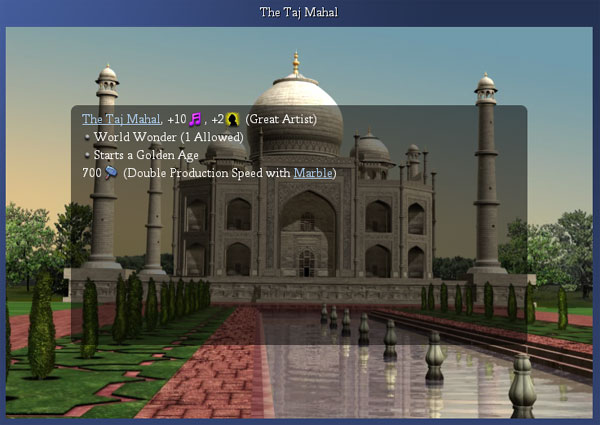
The Russangxi people were proud and numerous. In another country, they might have been persecuted for their audacity and waxing power. But the declining Moskva and Yangsten races were not disturbed, any more than parents would be disturbed for having raised successful children. They were embracing the new language and the new identity. They were making the success of the Russangxi into the success of the Russian Empire, and everything was attributed to the ingenuity and progressiveness of the Russian spirit.
When the Taj Mahal was raised to venerate that spirit, Russian nationalism and the Russangxi identity were unified.
Aside posted:
By building the Taj Mahal, I started a Golden Age! For eight turns, my empire will produce more commerce and more hammers. It's a good time to be king! (And to build infrastructure, and to upgrade units...)
You can also start Golden Ages by sacrificing two Great People. That tactic is exceptionally useful for bolstering the economy during speedy military victories, but since I'm playing for the long game, I'll get more out of my Great People by using their other abilities instead.
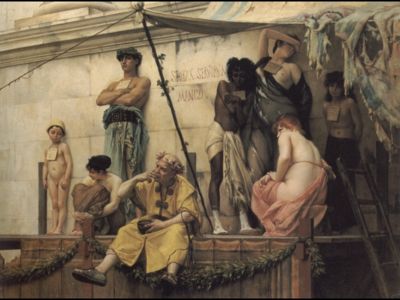
The Slave Market, by Kankrin.
Three hundred years had passed since the state had utilized slave labor. Since then, male slaves had been mostly used by grape farmers, textile plantations, and nobles in need of personal servants. Almost all female slaves were sold to Russian men as young wives.
The slave population was shrinking. They were ethnically Moskva or Yangsten--making them indistinguishable from their masters. Every year, escaping slaves blended into the labor population, and nobody could stop them. Except in a few isolated regions, most slaves may as well have been day laborers. They were paid a fair wage and were allowed to marry whomever they wanted.
Furthermore, the overall population was growing and wage labor was plentiful. In many ways, it was becoming cheaper for employers to hire a citizen than it was to raise and own a slave. By law, slaves had to be fed, clothed, and housed; there were no similar laws for citizens.
The population was beginning to find the entire institution distasteful. Because there were no obvious differences between the slavers and the slaved, slavery stank of a primitive barbarism. It seemed antithetical to the liberal principles and progressive spirit that invigorated the Empire. In the heart of the Russangxi party, savvy politicians intuited the near future of politics, and they quietly placed themselves in positions to exploit the coming flow of power. The most radical contingent of these politicians were eventually the most successful. They were the Emancipation Commission, formed in 1664.
1666 through 1670
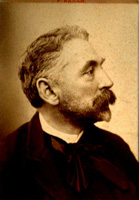
Grigory Aizenberg, head of the Emancipation Commission.
The Emancipation Commission was a group of ten Parliamentary members who advocated the abolition of slavery, the universal recognition of human equality, and the absolute condemnation of any foreign power that supported the "immoral practice of making one man the property of another."
Despite these liberal policies, the Commission modeled themselves after religious fundamentalists. They cast the issues in terms of morality. They appealed to religious principles and fiery Russian nationalism. It wasn't enough to say that slavery was outmoded and socially awkward. To seize power, they made it a conflict between the righteous and the wicked. Anyone who stood with them stood with the Russian Empire, "the model country before the eyes of the world." Anyone who stood against them stood with the barbarians, "the cunning Egyptians, the brutish Germans, the traitorous Spaniards."
They denied the existence of righteous foreigners. They ignored the existence of otherwise good Russians who still supported slavery. This kept the issue clear and in focus--simple. In the midst of a Golden Age, the struggle between good and evil was popular--the people willingly gave them power.
In 1670, the Emancipation Commission levered that power and pushed their head member, Grigory Aizenberg, into the chair of the Executive of Parliament. Aizenberg then persecuted his most vocal opponents in Parliament, driving several of them to resign under public outcry. One ousted member wrote,
"It is a crime. Through the will of the people, tyranny has been embraced. But if they do not want to hear dissent, I cannot speak it. No voice is powerful enough to drown out the roar of a crowd."
With their opposition weakened, the Emancipation Commission pressed to pass a series of laws before the summer closure of Parliament. Finally, two days before the session closed, they locked the doors on their chambers and forced a vote on abolition. Much of Parliament resisted this aggressive tactic and attempted to abstain, but Aizenberg insisted that the doors remain closed until the vote was taken. He swore to hold them for days, if necessary.
After twelve hours, two things occurred. Bitter enemies were made by the Commission, and the vote for the abolition of slavery passed by a margin of six members. The bill called for the immediate freedom of all slaves without recompense. Anyone in the slave business was about to lose a lot of money.
They did.
In the beginning of the new year, in 1671, they rioted.
---other events---
The Emancipation Commission gained a lot of power in Moscow by blocking Egyptian trade at the border of the Golden Plains. This protectionist act helped businessmen inside Moscow protect their investments in Grozny and St. Petersburg. Egyptians still used slave labor in a wide variety of industries, and their products were understandably cheaper. By casting the trade blocks as punishments "for the sins of slavery," the Commission gained popular support while surreptitiously applying the principles of Mercantilism.
Understandably, Egypt was furious. Their producers drained excess products into the larger Russian economy. With a block on the main trade artery, goods stockpiled, and prices plummeted on the Egyptian market. While producers lost their markets, Egyptian wages dropped dangerously, and thousands of workers lost their jobs.
1671 through 1675
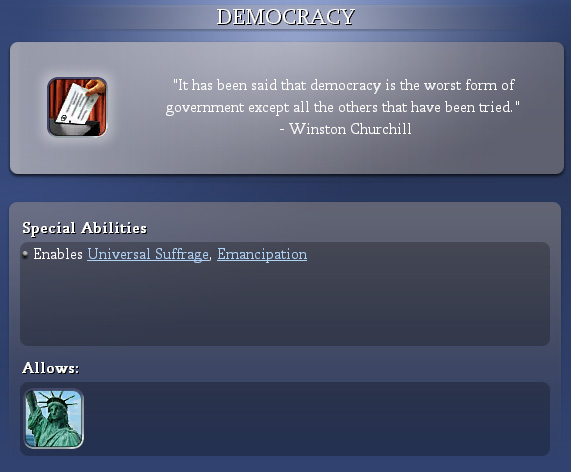
The civil unrest following abolition lasted for the next five years. During this time, Egypt's relationship with Russia deteriorated rapidly. At first they begged, but when that failed, they demanded that Moscow reopen the trade route to Memphis. When Russia refused, Egypt tried to throw out the Russian diplomat. When the diplomat was discovered rifling through Egyptian military records four months later, the Egyptians executed him and demanded that the Russian government reopen the trade route to repay them for the diplomat's subterfuge.Aside posted:
I just finished researching Democracy. Hooray! Universal Suffrage and Emancipation are both amazing civics, but I'm only going to apply one of them--Emancipation!
Universal Suffrage causes each town to produce +1 hammer, and it activates the "rush build" ability. With it, you can spend money in order to instantly build (or finish building) infrastructure and military units.
Emancipation bars you from using slavery and caste system because it is part of the same set of civics. But more specifically, it gives you two benefits. It causes a few points of civil unrest in every city of any empire without Emancipation. It also doubles the growth speed of cottages, villages, towns, etc. in your empire. This is incredibly important, since towns are the main source of commerce, and they would take forever to grow at the regular rate.
Democracy also does a few more things for you. It allows you to build the Statue of Liberty wonder, which gives you a free specialist in every city.
By the way, I went ahead and swapped from Hereditary Rule to Representation. This gives me a good chunk of research in combination with Mercantilism, since each free specialist now gives me +3 beakers.
In a normal game, I wouldn't switch civics during a Golden Age--I'd be wasting turns of high production and commerce! But I'm switching now because I feel like it!
Grigory Aizenberg ignored their demands and continued to turn away Egyptian traders. He was much too busy handling an internal political conflict. The Russangxi party was rapidly distancing itself from the Emancipation Commission, and some of its members had defected to the Denaturalists on the grounds that Aizenberg was a tyrant and not a proper executive.
---other events---
In 1673, the city of Rostov--an offshoot of Delhi's expanding population--founded its own provincial government. The governor of Shanghai granted the new province the southern half of the Shanghai Woods, from which Rostov would draw much of its early wealth.
1676 through 1680Aside posted:
As you can see, I founded a city to cover a bunch of undeveloped squares in the middle of my Empire. I find that it's good to "fill in the gaps" in the middle of the game. By the modern era, you want every scrap of land working for your country.
The green tiles are colored to show that they are already occupied by developed cities. Because I want those cities to run at maximum efficiency, I've made sure that all their tiles remain assigned to them. Rostov gets the red tiles, which represents every unused tile in the old Indian territory. Since I can easily afford as many cities as I like, I'm going to fill up the gaps and round out the coasts with tons of fishing cities. Each one will quickly net me a commerce profit.
In the meanwhile, I've been sending a Cossack to scout out the friendly Egyptian territory. They've got some weakly defended border cities and a bunch of heavily defended interior cities. They'll be a fun nut to crack.
In this period, an aged Durvin Nostikoff was elected to Parliament. Though he wasn't gunning for the Executive seat, he quickly discovered that he had similar authority. He was highly respected amongst both Denaturalists and Russangxi for his authorship of Doctrine: Mobilization, and when he spoke, they listened. In a surprisingly calm session in 1677, he motioned for a vote of no-confidence against Aizenberg. The vote passed rapidly, but before the sentence could be handed down, Aizenberg left the chamber, went to his office, and committed suicide with a flintlock. Instead of proceeding to a new Executive election, Aizenberg's secretary, Dominic Weledeev, succeeded him in his office.
In the week following Aizenberg's death, Weledeev contacted Nostikoff and offered a deal. He would publicly abandon the Emancipation Commission if Nostikoff supported Weledeev whenever he took action against anti-abolitionist rioters and dissidents. Nostikoff agreed, and by the end of the next election cycle, everyone in the Emancipation Commission--except Weledeev--was facing a total loss. The public still supported the simple fiery rhetoric of the Commission, but they would not stand for any representatives that would allow the anti-Abolitionist riots to return again and again for so many years. Weledeev in turn mobilized the military, and with Nostikoff's direction, they waged a police campaign in the remote anti-Abolitionist regions of the Empire: Saxon, rural Shanghai, the Novgorod Tundra, and similar areas. There wasn't any direct campaign against the civilians, but professional soldiers made hundreds of arrests. In short order, the anti-Abolitionist movement fell apart, and the emancipation of the slaves was complete.
But something worse was about to occur.
In 1680, a fleet of Egyptian smugglers were captured sailing into Port Kavkaz. For the last decade, such illicit trade had gone mostly unnoticed, and when it was discovered, the ships were gently turned away. Those denied shipments would simply move further down the coast to land along the placid, cold waters of Horse Mouth Bay near Novgorod, where black market merchants would offload the cargo and ship it for sale in the Russian Empire.
What made this event unique was that a naval officer decided to search one of the ships in the harbor. What he discovered horrified him: three hundred Egyptian and Agyptis girls were shackled down in the low hold of a barque. After interrogating and torturing the captain, the port authorities discovered that the women were destined to be sold as sexual slaves and wives in the Indian provinces. In a terrible diplomatic mistake, they rounded up whatever Egyptian sailors they could find in the city and jailed them on charges of slavery and pedophilia. Unknowingly, they nabbed three legitimate members of the Egyptian consulate from a bar and held them for execution. By the time the mistake was understood, the Egyptian government could only receive one of its officials in Thebes. The other two had been hung from the neck until dead.
Immediately, Egypt demanded huge reparations, the opening of the entire Russian border, and the release of all Egyptian nationals. Furthermore, they threatened to "forcibly liberate" any Egyptians who were arrested for committing any act that was legal according to Egyptian law--i.e. slavery.
Nostikoff understood the signs. He had prepared for this contingency for his entire life. He met with Wedeleev and the generals of the Russian military, and they began to plan for a war against Egypt.
So far...
Whee! MORE WAR SOON! I don't apologize for any typos, grammatical mistakes, or continuity errors. I did this one without a lick of revision (but tons of review of my own material).
